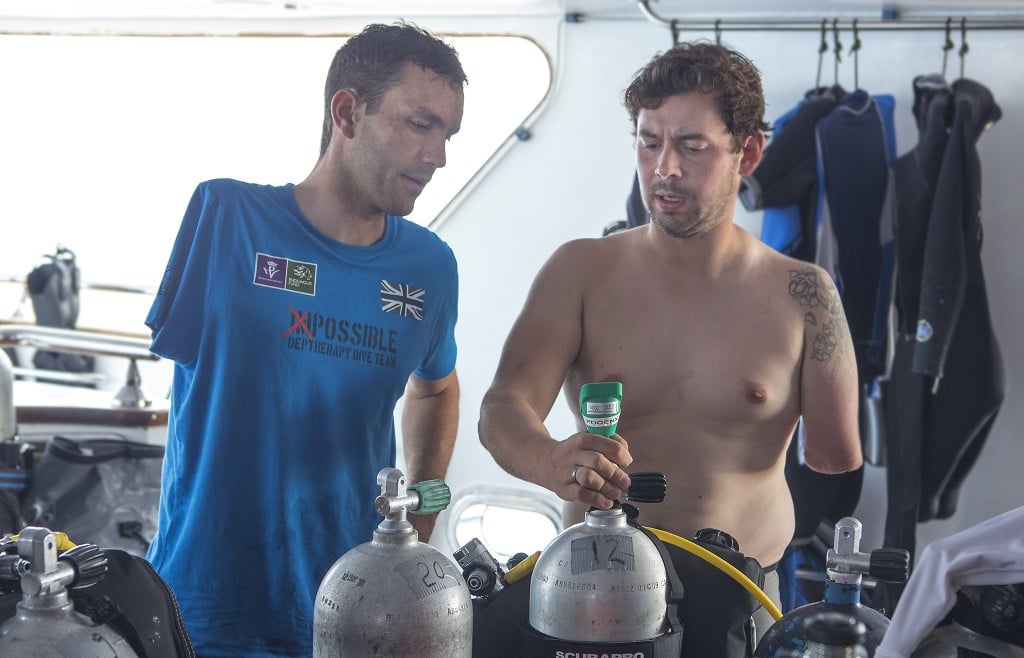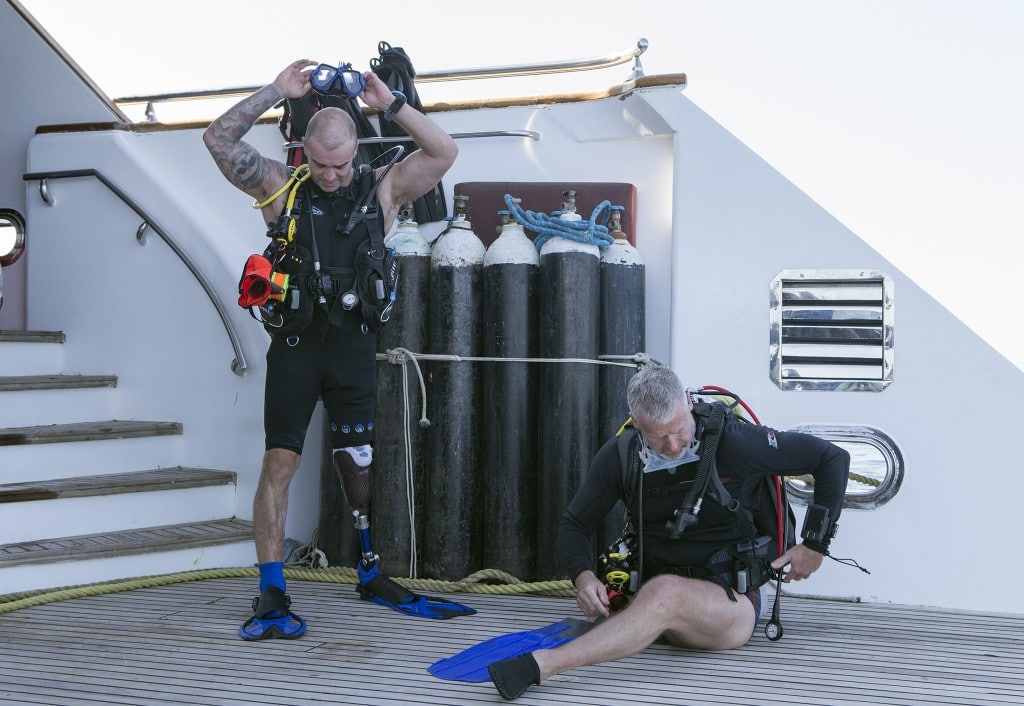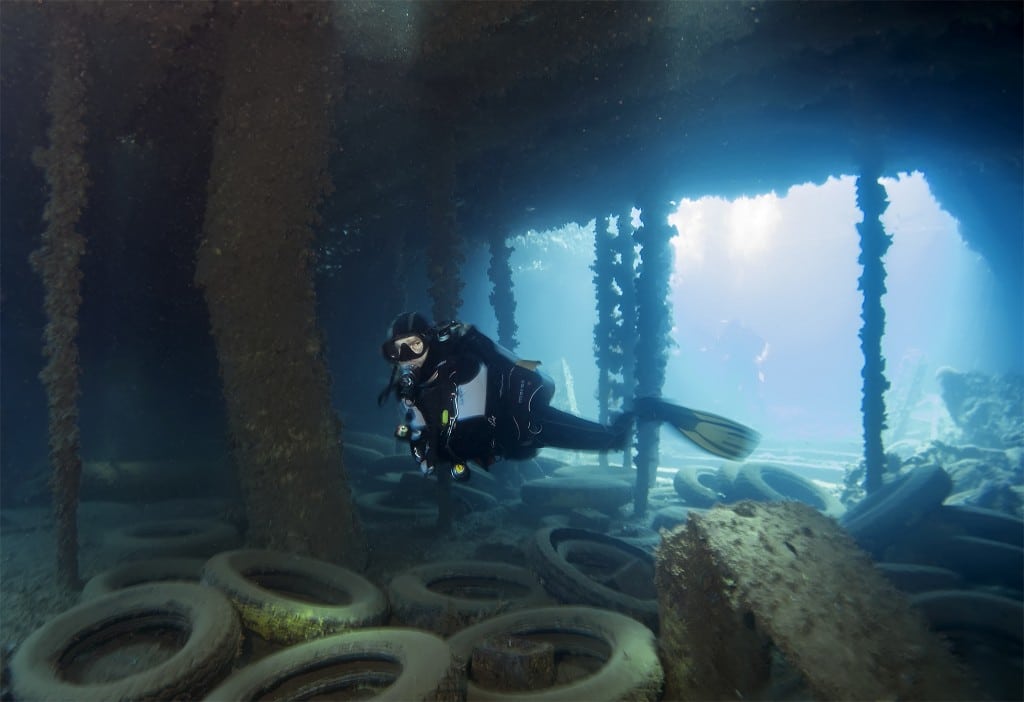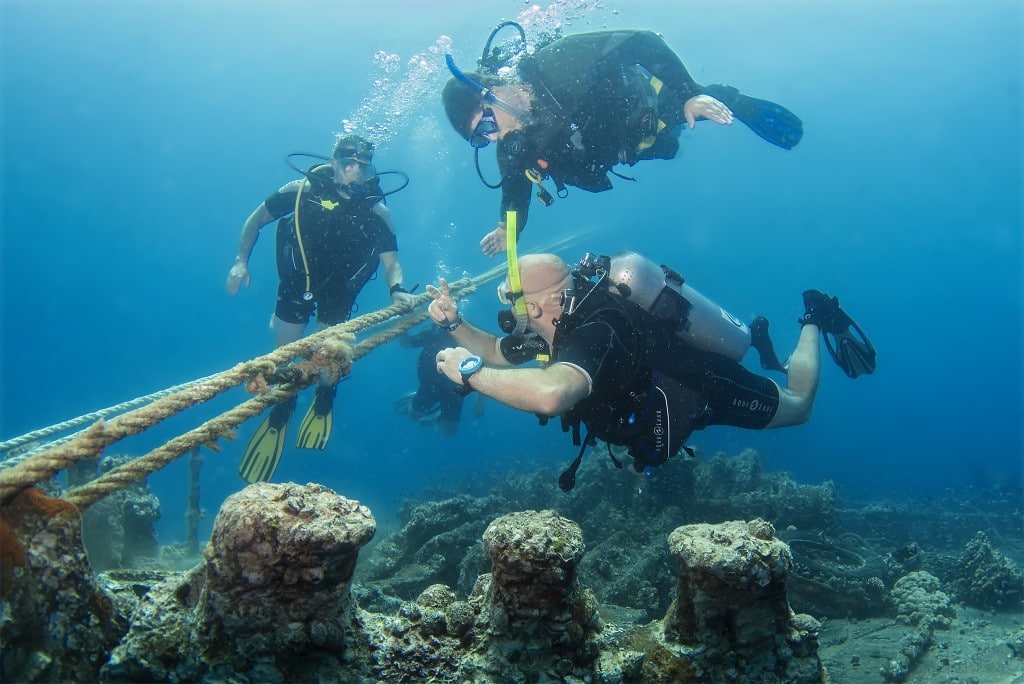News
Deptherapy’s Red Sea Wrecks – Part 2

Part two of Gary Green’s first hand account of the Deptherapy Red Sea Military and Forgotten Wrecks liveaboard expedition.
Day One: Umm Gamar (Check Dives)
So the first dives we took part in were the check dives. For a lot of the guys diving hasn’t been a permanent fixture in their lives. Some of them hadn’t been in the water since their PADI Advanced Open Water courses and this inevitably meant some skill fade and a lack of comfort in the water. Our pro instructors were well aware of this; in fact on this trip we had the luxury of six master instructors, which gave a ratio of two per dive team.
The day started before breakfast. We were awoken at 07:00 as we had to have our passports checked off by the Egyptian coast guard before we were allowed to set off on the open sea. This process wasn’t completed until about 08:30 and then we were able to set course into the Red Sea.
As we started our journey I was approached by Richard Cullen and Martin Weddell, who asked me if I would like to be a trainee divemaster. It was an honour to be asked; they said they believed in me and wanted to invest time to develop me, as someone who has come from the very bottom with the charity, in order to help to encourage, teach and inspire other wounded veterans to do the same. Chris Middleton had already gone through this process but was significantly more experienced than me. I was dubious at first as I didn’t think I had the capability. Chris assured me that I did and also, that the only way to start learning, was to start training. I agreed and felt uplifted that my title had already been upgraded from Rescue Diver to Trainee Dive Master. I admit it has a certain ring to it!

The journey across the water took roughly two hours and we arrived at Umm Gamar around 12:00, entering the water at about 12:30. The first thing we had to do in the water was a weight check. As I mentioned, some of the guys hadn’t dived in a year so their buoyancy, weight and kit were all potentially different. Before we went on the wrecks we needed to ensure that we would be able to dive to the required standard, otherwise things could go wrong. We were able to use this dive to make sure things were comfortable, our kit was how we wanted it; not only that but we were able to make sure things were where we could use them most comfortably. As I had been diving in the UK, I found this process quite easy and knew how and where I wanted my kit. The only thing I changed was adding a couple of kilogram weights to the back of my BCD as I felt a bit lighter in the salty Red Sea than I did at Wraysbury reservoir.
The reefs of the red sea really are the most beautiful; the colours are so vibrant and the visibility on both of the dives we did at Umm Gamar was around 30 meters. It was like being in an aquarium. The first dive as a group was not brilliant. The skill fade had set in and possibly a bit of over excitement; our spacing was not brilliant and our buddy drills were… well, spacious! After every dive we have a debrief. It’s never a negative thing, more of a learning point, re-emphasising points such as spacial awareness and buoyancy techniques. In Red team it seemed we had all the smokers, including myself (naughty boy I know) so the debriefs were always on the smoking deck; bonus.
The second dive was better. I still felt a bit underweighted and added one kilo in each of my integrated pockets. I had a good dive and my drills were still good but I felt a bit uncomfortable, constantly pinching in a bit of air. As soon as I was out of the water, the extra weights went straight back in the pile. We also had to shoot up an SNBD, which I think almost none of us had done before. We were told that this was a necessity in case we were blown off the wreck. Basically if you couldn’t do it then by the time anyone noticed you were missing you could be in Saudi Arabia! With that positive thought in mind, we all shot them up without hesitation.

After the dive that day everyone felt more comfortable and confident. At dinner we all chirped about the day’s diving, speculating also about what was to come. It was an eight-hour journey to our next destination, which was our first wreck, the SS Turkia and where we were to do our PADI Wreck Diver course. That evening we all congregated in the briefing room. We received an in depth history on the wreck and then completed the knowledge reviews from the wreck diver manual as a team. Once they were complete, it was time to fall asleep to the rocking waves of the Red Sea and await our arrival at the wreck of the SS Turkia.

Day Two / Three: SS Turkia (PADI Wreck Diver Course)
Waking up an hour off schedule meant that we were still rocking back and forth, to my knowledge though, no one was sick. I did feel slightly nauseous though but I’m not sure if that was the wavy sea we encountered or the posing of Paratrooper Luke Morrison that we had to put up with! We had our individual dive briefs in our teams, red, white and blue (the colours of the union jack, very patriotic and apt, especially on a boat named the Princess Diana). The first dive was also the first dive that I was asked to lead as a trainee Dive Master and so I made sure I listened to the brief intently. I love the entry into the water from the dive deck. Most of my experience had been shore diving and there’s an added element of excitement when you jump from the boat and make a big splash into the water, especially when you’re leading the dive.

Before we entered the water I checked that everyone had done their buddy checks. The ok sign came from the team and splash, splash, splash, we all entered the water two by two. I got the OK sign off everyone as we bobbed on top of the water like the last bits of cereal caught in the swirl of the milk. I gave everyone the ‘down’ sign and watched as we simultaneously sank beneath the water. I kept eyes on the guys in case anyone had trouble leaving the surface; the last thing I would want is to get down the shot line and realise someone has drifted a few hundred meters away. Everyone was ok and we followed the shot line down on to the stern of the shipwreck.
Even about ten meters above the actual wreck we could all see the super structure. It’s a beautiful wreck and is still relatively intact. I had previously dived the Salem Express and this wreck was similar in the sense that it was a big ship and fills your vision as you lower onto it. The sense of amazement hasn’t left me as you see the shape of the wreck come into view; then as you get closer you notice the life that surrounds it inhabiting the soft corals that have developed over the years.

This first dive was the orientation; it was part of the course syllabus and designed to get the divers used to the entry and exit points of the wreck. It’s all part of dive planning to know even the basic shapes of what you are diving. The dive is also used to highlight points that you want might to avoid, any surges in current and possibly hazardous points that could be mistaken as a good entry point. As I was leading the dive, I took the team around the circumference of the wreck, highlighting points of interest and potential entry points as we went along. The dive was a success and the objective was completed. Also, my main objective was that I never lost anyone and that we all came back safe, which we did. We were well and truly orientated on what I consider to be my favourite wreck of the whole trip.
The second dive was a sketch dive, where we all had to take down a slate and a pencil. The aim was that we would all head to different parts of the wreck and sketch points of interest, so that we could plan exactly where we would penetrate. We recorded the depths, estimated sizes etc. in order to put them together and potentially be able to make out the whole wreck. Let’s just say that it didn’t quite look like the wreck, in fact, it looked more like a class of five year old’s crayon drawings stuck together but we all managed to explain our drawings in the debrief and were able to depict the information that was needed. To be completely honest though it looked like a comedy sketch from a Carry On film (Carry On Diving?) – all we were missing was Barbara Windsor.

With the orientation of the wreck done, plus the sketch on the slates highlighting hazards and entry points, we were then allocated a night dive to do (a leisure dive). I had already fallen in love with the wreck; the sight of it amazed me and the potential exploration that could be done. I fell in love with passages, the entry points, the history and the mystery that bestowed the wreckage left beneath the sea. We jumped into the water with our torches brightly illuminating the sea like an underwater firework display. Lowering just a few meters you could see the directions of the torches beaming across the wreck. The structure was completely lit up as the divers switched their beams from point to point as their eyes spotted points of interest.
We lowered onto the wreck where (as we were briefed) it was full of black spine urchins and we kept well clear. The wreck was now full of different marine life. A whole new aquatic world had opened up at night; large fish patrolled the area above the wreck and there were a few lionfish still in the vicinity awaiting an unaware diver to provoke its sting. It seemed some of the smaller fish were hiding. There was definitely an eerie feeling on the wreck; the bright colours had transformed to darker colours and the plankton in the water was highlighted by the torch beams, giving a slight layer between divers’ eyes and the torch.

The next day was line laying and penetration day! As you can expect, there were lots of jokes about ‘penetration’ with a boat full of ex-squaddies. We had gone through the drills of line laying on the top deck, learning how to keep a continuous line as you wrap your reel around strategic points, such as the turn of a corner or the entrance of a door or window. I didn’t find the line laying on the actual wreck any harder or easier underwater; the drill was exactly the same. What was quite challenging though was keeping buoyancy as your attention moved onto something else. The trick was all about keeping your calm and taking your time.

We entered the wreck through a doorway which led to some passageways. At the first tie off point I wrapped the reel round three times, two times on the second and then one loop on each of the other points. At each point I locked off the tie so that the line remained continuous so that if the room we were in became silted or we needed to get out of the wreck, we had an easy route to take. Afterwards we were passed off as Wreck Divers with a few other tests that we completed, and then we were free to enter the water as buddies and take our own routes (still under the supervision of instructors just in case something went wrong). The next dive on the Turkia was more relaxed as there was no pressure of being assessed; also we had clearance and light above of the entry points so we were able to explore the wreck without needing to lay a line down.

On the second night we had to complete our Enriched Air Diver Course so that we could dive the next wrecks with Nitrox. On some of the dives we would need Nitrox so that we would have a higher no decompression limit, however, this meant we would need to watch our maximum depth, which I now know because I completed the course (want me to go into partial pressure of oxygen?). We did the course with Steve Rattle and I found it really interesting. I am a bit of a geek, though, so any new subject I take a grasp of, I tend to enjoy. The knowledge review was quickly conquered and I was classified as an Enriched Air Diver, which meant I was now allowed to dive with Nitrox.
Come back tomorrow to read Part Three…
Donate to Deptherapy or find out more about their work at www.deptherapy.co.uk
Thanks to Dmitry Knyazev for the incredible photographs.
Gear News
Introducing the TR-80, IR-50 and CS-30 Regulators from DYNAMICNORD

Whether you are a beginner or a professional diver – with the three new main regulators from DYNAMICNORD, everyone will find their favourite regulator. They all look super stylish.
Excellent performance with the TR-80
Quality and performance are the be-all and end-all for regulators. It is not for nothing that the TR stands for Tec Reg. The innovative design of the TR-80 guarantees absolute reliability – even in ice-cold waters.

Perfect breathing effort at 0.8 J/l / certified for diving in waters below 10 degrees / structural design made of solid brass for best cold protection / membrane-compensated design with dry seal of the first stage / reduced exhalation effort thanks to optimized exhalation membrane and bubble deflector / adjustable Venturi (dive/predive) and adjustment knob for individual inhalation comfort / innovative design of the front cover prevents free-flow in strong currents or when diving with scooters / design made of sandblasted brass, matt chrome finish / 2 HP and 4 LP outlets / mouthpiece made of high-quality, anti-allergic silicone for maximum comfort.


Amazing underwater adventures with the IR-50
The IR-50 is the top regulator for advanced and experienced divers. Natural breathing is the essence of this regulator.

Ideal breathing effort at 0.8 J/l /certified for diving in waters below 10 degrees / compensated membrane / adjustable venturi (dive/predive) and adjustment knob for individual inhalation comfort/ outlet valve and deflector for minimum exhalation effort and reduction of bubbles on the face / design made of sandblasted brass, matt chrome finish / 2 HP and 4 NP outlets / mouthpiece made of high-quality, anti-allergic silicone for maximum comfort.


The Workhorse – our CS-30
For diving centres and diving beginners – the workhorse stands for strong construction, reliability and robustness. Perfect for your training.

Optimal breathing effort at 0.8 J/l /recommended for diving in waters above 10 degrees / non-compensated piston / adjustable venturi (dive/predive) / outlet valve and deflector for minimum exhalation effort and reduction of bubbles on the face / design made of sandblasted brass, matt chrome finish / 1 HP and 3 NP outlets / mouthpiece made of high-quality, anti-allergic silicone for maximum comfort.


Octopus OP-30
The OP-30 is the ideal addition to all DYNAMICNORD regulators. It is identical in construction to the CS-30.

The TR-80, IR-50, CS-30 (DIN & INT) regulators and the Octopus OP-30 are available from DYNAMICNORD dealers and in the online store.
DYNAMICNORD – Your Outdoor Companion.
Marine Life & Conservation
Paul Watson Released as Denmark Blocks Japan’s Extradition Bid

Renowned anti-whaling activist Paul Watson has been released from custody in Greenland after spending five months in detention. Denmark’s Justice Ministry rejected Japan’s request for his extradition, citing insufficient guarantees that his time already served in custody would be credited against any potential sentence.
The 74-year-old Canadian-American was arrested on July 21 in Nuuk, Greenland’s capital, when his ship docked to refuel. His arrest was based on a 2012 Japanese warrant related to a 2010 encounter in Antarctic waters. Japan alleged Watson obstructed operations and caused damage to a whaling research ship during efforts to disrupt illegal whaling. Watson has consistently denied these claims, maintaining his commitment to marine conservation.
Denmark, which oversees extradition matters for Greenland, concluded that while the legal conditions for extradition were met, the lack of assurances from Japan regarding time-served credit made extradition untenable.
In a video shared by his foundation, Watson expressed gratitude and relief, saying, “After five months, it’s good to be out… and good to know they’re not sending me to Japan.” He added that the most difficult part of his time in custody was being separated from his two young sons.
Watson is a pioneering figure in marine conservation, known for founding the Captain Paul Watson Foundation in 2022 after decades of activism with the Sea Shepherd Conservation Society. His bold efforts to defend marine life have earned him widespread support, including from celebrities and conservationists. His work has also been featured in the acclaimed reality TV series Whale Wars.
Watson’s lawyer, Jonas Christoffersen, praised the decision, stating, “We are happy and relieved that Paul Watson is now free.” He added that Watson is eager to reunite with his family and continue his vital work.
The arrest occurred while Watson’s vessel, the M/Y John Paul DeJoria, was en route to the North Pacific with a team of 26 volunteers to intercept a Japanese whaling ship. His foundation described the arrest as politically motivated and emphasized that Watson’s actions were focused on ending illegal whaling practices.
Japan resumed commercial whaling in 2019 after leaving the International Whaling Commission, asserting that whale meat is a cultural tradition. Conservationists, however, continue to challenge these practices, highlighting their impact on marine ecosystems.
Despite the challenges, Watson remains steadfast in his mission to protect marine life and bring attention to whaling practices. His dedication to ocean conservation has made him a globally respected advocate for the environment.
-

 News2 months ago
News2 months agoIconic SS United States to become the World’s Largest Artificial Reef
-

 News3 months ago
News3 months agoBook Review – 52 Assignments: Underwater Photography
-

 Gear News3 months ago
Gear News3 months agoDYNAMICNORD – New German diving brand enters the British market
-

 News3 months ago
News3 months agoExploring Cenote El Pit: A Diver’s Dream
-

 Gear News3 months ago
Gear News3 months agoTry BARE drysuits (and maybe even win one!) this Friday with Sea & Sea at North West Dive Fest
-

 Marine Life & Conservation3 months ago
Marine Life & Conservation3 months agoBook Review: Coral Triangle Cameos
-

 Blogs2 months ago
Blogs2 months agoDive the Egyptian Red Sea this Autumn with Regaldive
-

 News3 months ago
News3 months ago2024 Ocean Art Underwater Photo Competition Announced















